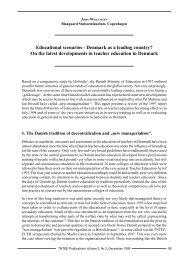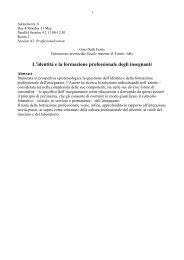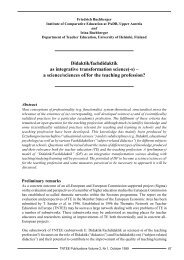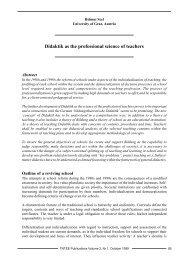TNTEE Publications - Didaktik/Fachdidaktik
TNTEE Publications - Didaktik/Fachdidaktik
TNTEE Publications - Didaktik/Fachdidaktik
Create successful ePaper yourself
Turn your PDF publications into a flip-book with our unique Google optimized e-Paper software.
Pertti Kansanen<br />
University of Helsinki, Finland<br />
The Deutsche <strong>Didaktik</strong> and the<br />
American Research on Teaching<br />
Abstract<br />
This chapter presents an historical overview of the development of the “Deutsche <strong>Didaktik</strong>” and<br />
compares it with the American tradition of research on teaching. This tradition is traced back to<br />
Johan Amos Comenius in the 16 th century as a practical and normative doctrine and various trends<br />
within the 20 th century are identified. The absence of almost any discussion of <strong>Didaktik</strong> in British<br />
and American literature is highlighted. In relation to this phenomenon, there is a discussion of how<br />
the traditions (Deutsche <strong>Didaktik</strong>/Anglo-American curriculum theory) separated in response to<br />
political and ideological circumstances. It is noted that reform pedagogy and new conceptualisations<br />
of <strong>Didaktik</strong> did not reach American education. In addressing the aspect of <strong>Fachdidaktik</strong>, it is<br />
argued that only erudition-centred <strong>Didaktik</strong>/Geisteswissenschaften has a clear position on this<br />
question. In essence the main task in this tradition is seen as a theory of educational content (Theorie<br />
der Bildungshalte) according to its value in the curriculum and in the instructional process. Finally<br />
some observations are offered on the Nordic alternative and the conflict between the different<br />
traditions of educational psychology/empirical research and geisteswissenschaftliche <strong>Didaktik</strong>/<br />
hermeneutics is highlighted.<br />
Introduction<br />
My interest in <strong>Didaktik</strong> began in my early studies in the psychology of education and learning<br />
theories. All the textbooks were in English or in Swedish and the students of my generation got a<br />
very thorough understanding of the American way of thinking in educational problems and how to<br />
do research correctly. There was only one way: according to the method of science. In the late<br />
1970s I found Wolfgang Klafki’s book Studien zur Bildungstheorie und <strong>Didaktik</strong> in a book sale. I<br />
remember that I understood practically nothing of its content.<br />
As a university teacher of the foundations of education one of my courses was about the basics of<br />
<strong>Didaktik</strong>. It was always confusing to use the concept of <strong>Didaktik</strong> without really knowing what it<br />
meant. I knew that it came from Germany but its content was from the American curriculum research<br />
or from American educational psychology. Although we co-operated with the IPN in Kiel when the<br />
curriculum research was at its peak in the 1970s the content of the <strong>Didaktik</strong> was in the background.<br />
At that time there was no need to get acquainted with the human sciences or Geisteswissenschaften<br />
or its method, hermeneutics.<br />
Gradually, when general attention began to focus more and more on the theoretical background of<br />
the empirical models, the question of the nature of the <strong>Didaktik</strong> became of current interest. In<br />
Finnish teacher education <strong>Didaktik</strong> is the main subject and, because my chair represents teacher<br />
education, it became a personal problem to find an answer to the question What really is <strong>Didaktik</strong>?<br />
<strong>TNTEE</strong> <strong>Publications</strong> Volume 2, Nr 1, October 1999 21








